Obese & Overweight Dogs: Chart, Symptoms, Treatments | Pupford
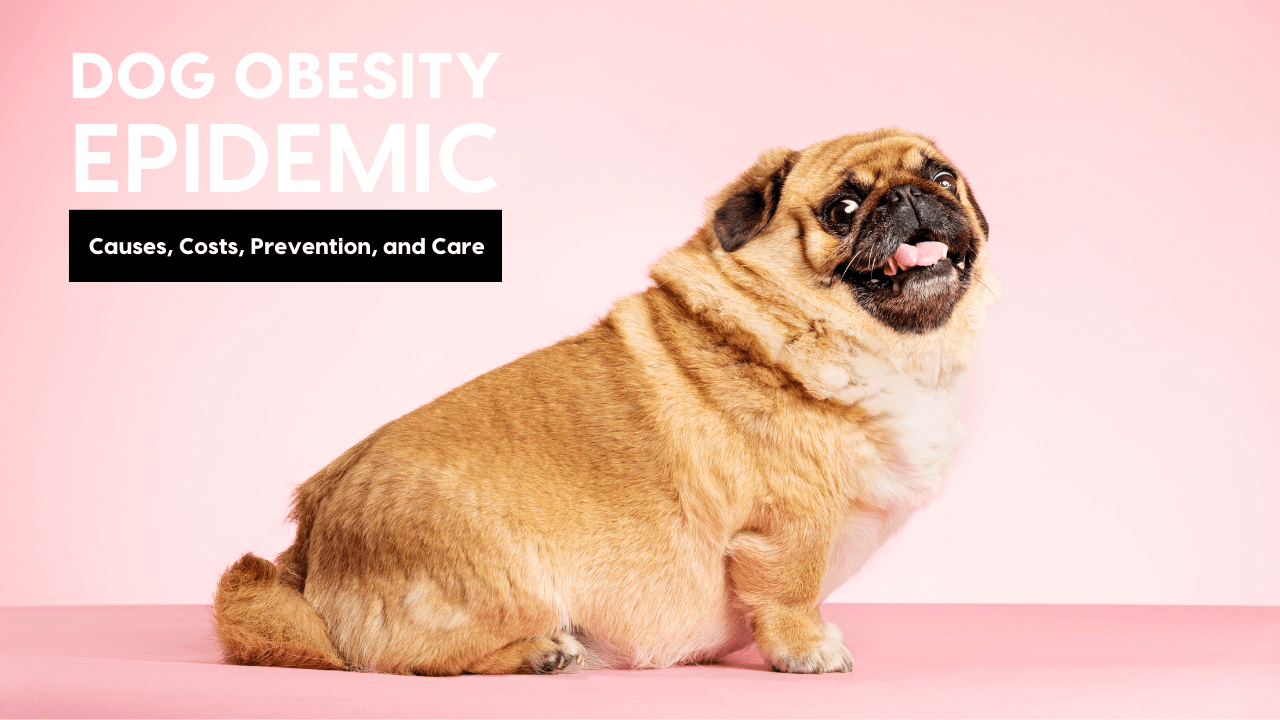
It may be tempting to spoil our dogs with treats, special meals, and lots of snuggles. But when does that become too much?
There’s a difference between a well-loved, well-fed dog and an obese or overweight dog. And unfortunately, obesity can be a serious problem for our dogs.
According to the Association for Pet Obesity Prevention (APOP), 54% of dogs in the United States are classified as overweight or obese. This marks an increase in the obesity rate in pets for nine consecutive years. If that sounds like a problem to you, that’s because it is.
This isn’t meant to scare anyone or shame any pup parents -- quite the opposite actually. We’re here to take a good hard look at why dog obesity is an accelerating epidemic and what you can do to keep your dog healthy.
In this article, we’ll be covering:
- The dog obesity epidemic
- Causes of obesity in dogs
- Health issues caused by obesity in dogs
- Cost of obesity in dogs
- How to know if your dog is overweight
- Caring for an obese or overweight dog
- Preventing obesity in dogs
Let’s pause for some dog weight trivia!
OVERWEIGHT DOG PODCAST
Want to hear more podcasts like this? Please click here.
VIDEO VERSION
Want to see more videos like this? Please click here.
OVERWEIGHT & OBESE DOG STATISTICS
Before diving into dog obesity, we need to highlight some important statistics.
- As mentioned above, about 54% of all dogs in the US are overweight or obese
- Of that number, roughly 25% are obese
- Excessive weight gain is the #1 preventable disease in dogs
- Over 100 million dogs are considered overweight or obese
- Pet obesity has increased for 9 consecutive years
- It's been clinically proven that obese dogs live shorter lives
STOP and take that in for a moment...
Especially the fact that excessive weight gain is the #1 preventable disease in dogs! 😳
Now, let's look at 2 important definitions.
WHAT'S THE DIFFERENCE BETWEEN AN OBESE VS OVERWEIGHT DOG?
When discussing this problem, we need to define overweight and obese.
Overweight: A dog is considered overweight if he/she is 10% over their ideal weight
Obese: A dog is considered obese if he/she is 20% over their ideal weight
We will discuss the ideal weight later on but let's look at an example of a dog who has an ideal weight of 30 lbs.
This dog would be considered overweight at 33 lbs or more.
This dog would be considered obese at 36 lbs or more.
So the next question naturally is... why do some dogs become overweight or obese? 👇
🐶 Protect your dog's ideal weight with low-calorie treats (often 1kcal or less). Shop here! 🐶
CAUSES OF OBESE & OVERWEIGHT DOGS

Like anything else, finding a solution starts with understanding why the problem is happening.
The thing about obesity in dogs is that it’s rarely one single thing that causes it, but rather a combination of causes. The most common causes of overweight dogs are:
- Lack of awareness by people as to what a healthy weight for their dog is and how to recognize when weight is becoming excessive
- Lack of compliance by dog parents (we know how hard it can be to say no to “that face”)
- Genetic susceptibilities or mutations
- Overfeeding via unmeasured feeding, free feeding, or food stealing in multi-dog homes
- Feeding of calorically-dense foods and/or table scraps
- Showing love and affection solely through treats
- Lack of appropriate exercise for the dog’s age/breed/activity level/calories consumed
It’s important to stress that often dog parents aren’t even aware they’re doing these things. It’s easy for “a piece of chicken here,” and “an extra treat there” to add up over time and lead to weight issues, even with the best of intentions.
The first step in making changes for your dog's weight is being aware of what is causing that weight gain!
OVERWEIGHT DOG PROBLEMS & HEALTH RISKS
It’s important for dog parents to recognize what they’re doing to affect their dog’s weight and correct it if necessary. If not, obesity can lead to major health issues.
Here are the top 10 obesity-related conditions in dogs, according to Vet Innovations:
- Arthritis
- Bladder/Urinary Tract Disease
- Liver Disease
- Low Thyroid Hormone Production
- Torn Knee Ligaments
- Diabetes
- Diseased Disc in the Spine
- Chronic Kidney Disease
- Heart Failure
- High Blood Pressure
These are only the top specific diseases -- obesity can play a factor in many forms of inflammatory conditions and cancers too.
Not to mention... 👇
- Joint problems
- Inflammation
- Organ dysfunction
- Challenges with heat exhaustion
Nobody wants to see their dog sick, especially with diseases like these that can be uncomfortable for your dog and even shorten their lifespan.
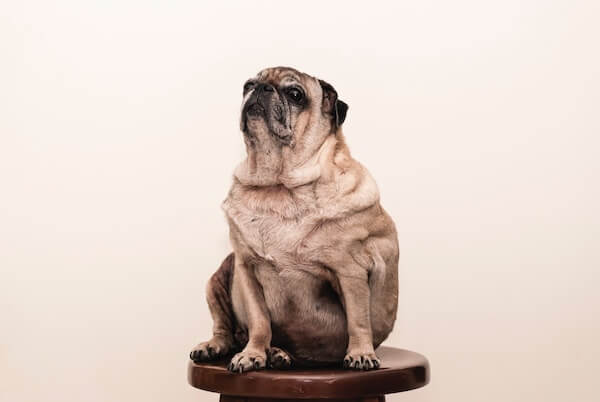
COST OF OBESITY IN DOGS
Not only does obesity have costs when it comes to your dog’s health, but it can also be financially costly as well.
🐶 Protect your dog's ideal weight with low-calorie treats (often 1kcal or less). Shop here! 🐶
Here are some example scenarios of what obesity-related illnesses can cost, with data provided by PetPlan (as of 2017):
- When dogs eat more than they should, they can develop digestive issues. The average cost of treatment for things like vomiting, diarrhea, and excessive gas is $850.
- Overweight dogs are more susceptible to certain cancers, and the average cost of treating cancer in dogs is $2,033.
- Joint issues are common in overweight dogs. Arthritis can cost $966 while more serious ligament issues can cost $3,480.
- Urinary tract infections are not only painful and uncomfortable for your pup, they carry a $590 price tag to treat
- Heart disease caused by obesity-related high blood pressure often costs around $1,232 to treat
- Disc diseases are not only very limiting for your dog’s mobility, they can cost $2,033 to treat.
While we know we can’t put a price tag on your dog’s health, finances are a very real part of being a pup parent so it’s important to consider.
HOW HEAVY SHOULD MY DOG BE, IS MY DOG OVERWEIGHT?

As a pup parent, it's vital you know your dog's ideal weight. You should discuss this with your vet.
Let's repeat that... You should 100% discuss your dog's ideal weight with your vet.
Another way to know how heavy your dog should be is by using the Body Condition Score (BCS).
DOG OBESITY CHART & BODY CONDITION SCORE (BCS)
The Body Condition Score (BCS) for dogs is similar to a BMI score in humans.
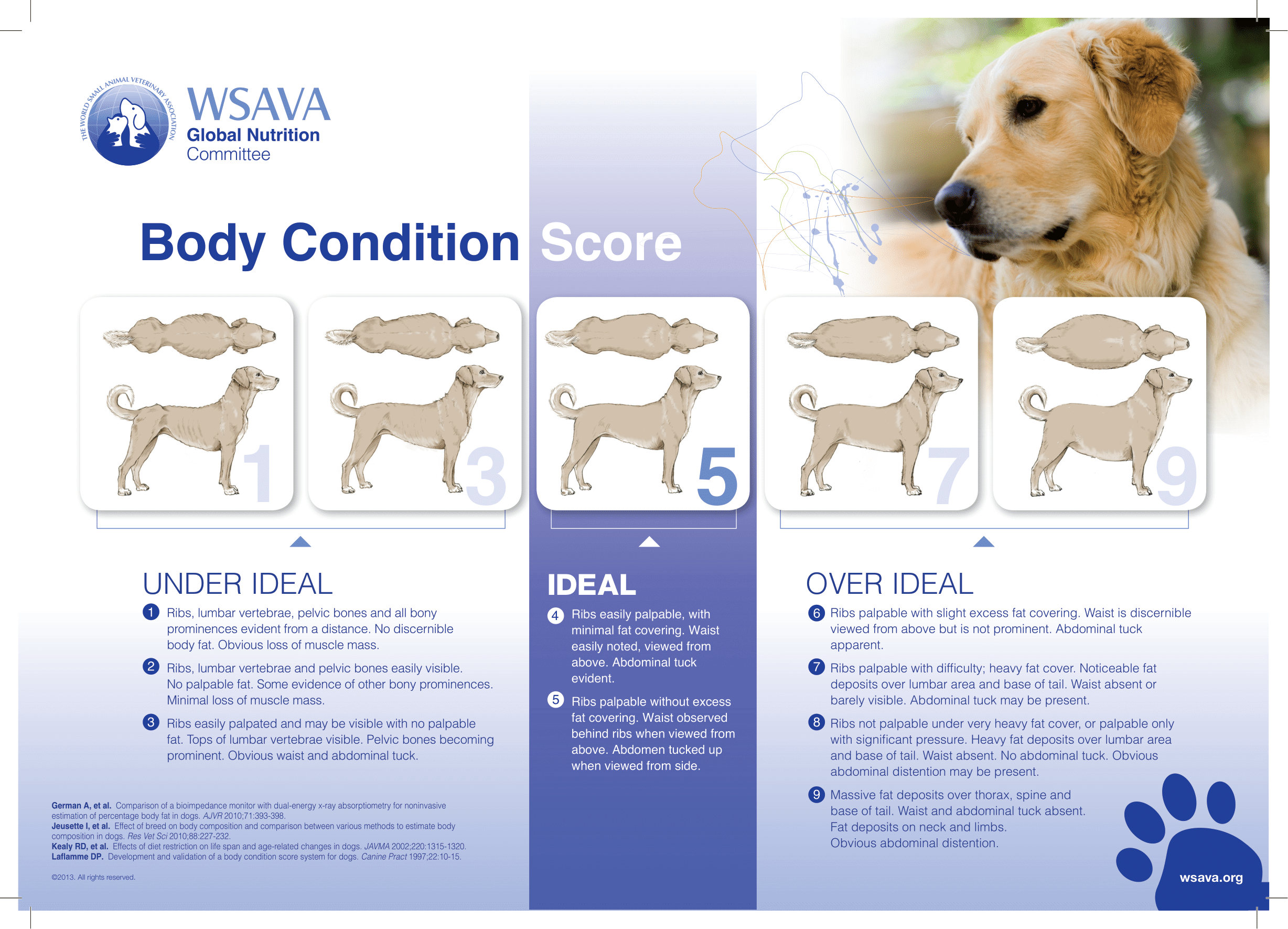
You can use the BCS chart above to make an assessment of your dog's weight.
Here's how to assess your dog's Body Condition Score (ideal is 4-5):
- Feel rib cage - you want to be able to feel dogs ribs and distinguish between each rib, without them jutting out at you
- Looking at your dog straight down, you want to see the waist from behind the ribs
- Look at dog perpendicular to you- and check where the rib cage ends, you want to see the stomach tuck up into the abdomen
Please consult your vet with this process, they will be able to provide a complete assessment of your dog's Body Condition Score.
Now that you have an idea of your dog's BCS, let's look at how to care for an obese or overweight dog. ⬇️
🐶 Protect your dog's ideal weight with low-calorie treats (often 1kcal or less). Shop here! 🐶
CARING FOR AN OBESE OR OVERWEIGHT DOG
If your dog is overweight, there are things you can do to care for them and keep them healthy.
First, you’ll want to schedule regular wellness exams with your vet. You definitely want to have a professional make sure your dog is in good overall health as well as monitor for signs of future illness or disease. Ask your vet for a list of warning signs to be on the lookout for so that if any conditions develop, you can catch them early.
The vet will also be able to keep an accurate log of your dog’s weight and recommend dietary plans accordingly. Make sure you’re sticking to your veterinarian-prescribed feeding protocol, even though it may be tempting to break it “just this once.”
In addition, it’s important to make gradual lifestyle changes like adding exercise and changing the foods and treats you give your dog (more on that in a little while!). Too many drastic changes like going from no exercise to an hour a day may be a bit of a shock for your dog.
Start slow, keep a careful eye on your pup, and incorporate some of the tips we cover in the next section.
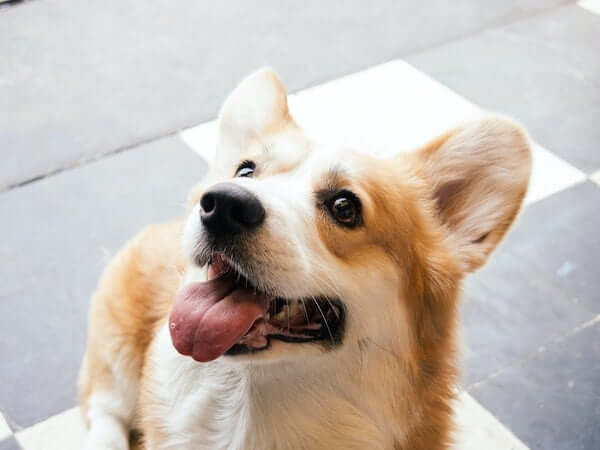
PREVENTING OBESITY IN DOGS
If your dog is already overweight, you can use some of these habits to get their weight down. If your dog isn’t overweight, let’s keep it that way!
These tips for preventing obesity in dogs can help keep your pup healthy and happy at any weight:
- Get informed. Ask your vet what the appropriate weight range for your dog is and weigh them regularly. Find out the acceptable calorie range for losing weight or maintaining healthy weight.
- Use low-calorie treats. Treats are an important tool for training, so you aren’t expected to eliminate them altogether. Just make sure you are choosing a low-calorie treat option and that treats are not making up more than 10-15% of your dog’s diet. Shop low-calorie dog treats here. You can also try dog-friendly fruits and veggies!
- Spoil wisely. When your dog is extra good in the bath or does something that deserves spoiling, do so wisely. Choose a protein-based, no-sugar option to reward your dog without unnecessary calories. Our one-ingredient jerky treats are a guilt-free way to give your dog an extra special treat. Shop dog jerky treats here.
- Exercise. Taking your dog for walks, playing fetch, and training can provide the exercise your dog needs to maintain a healthy weight -- it will also lead to a better behaved pup! Is the winter weather preventing you from getting outside with your pup? Here’s an interview with trainer Trevor Smith about exercising your dog in bad weather.
- Make some simple swaps. Before giving your dog something, think “is there a healthier way to do this?” Here are some ideas for simple swaps that cut calories, without cutting love and excitement for your dog:
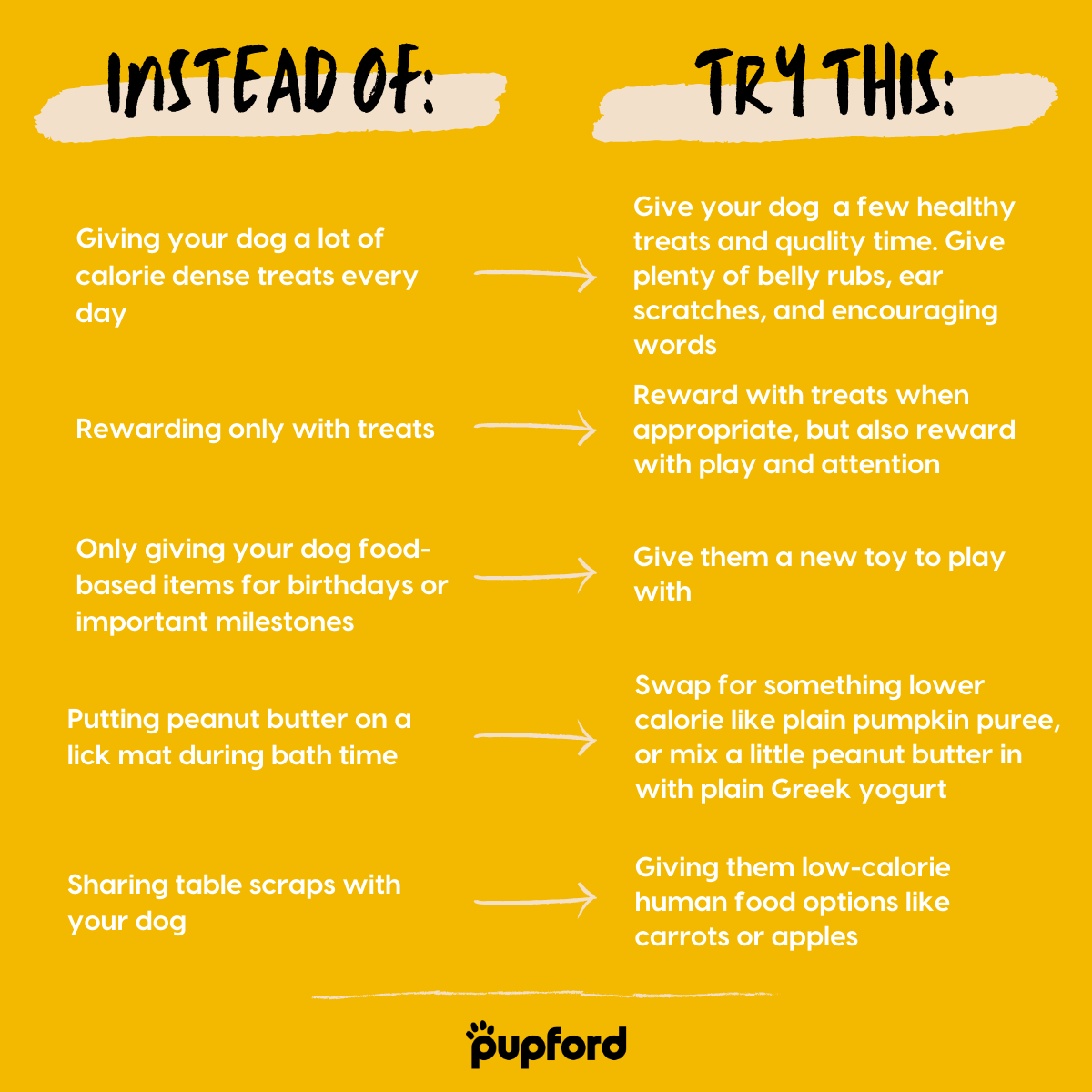
OVERWEIGHT DOGS & OBESITY RECAP
It does take effort to get your dog to a healthy weight and maintain it, but sometimes even little things help. Something as simple as swapping treats and rewards for healthier options can make a big difference.
Our dogs rely on us for many things, so be sure to choose treats and chews that don't provide excessive calories for your pup!
Shop our full line of low-calorie treats here!
Did your dog ever experience losing weight or creating a healthier lifestyle for your dog? We’d love to hear about it in the comments!
🐶 Protect your dog's ideal weight with low-calorie treats (often 1kcal or less). Shop here! 🐶
0 Comments